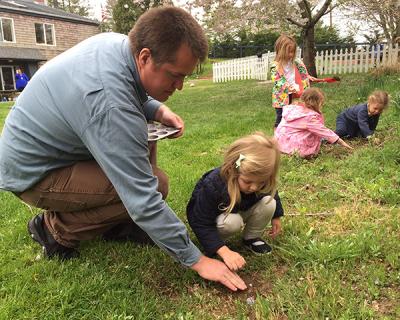Greening the School at Ross

Fifteen of the Ross Lower School’s littlest students raced around the school’s playground on Tuesday cradling potted seedlings in their small but capable hands. They were charged with an important task: Finding places to plant them among the gardens at the edges of the playground.
Last week, Bryan Smith, one of the school’s science teachers, helped students in the pre-kindergarten and nursery classes make the biodegradable pots using layers of recycled paper pulp, in which they planted various native flowers. By Tuesday, to the students’ delight, their seeds had sprouted, and right after they finished finding spots to plant them, the weather changed from cloudy to rainy. Just in time, Mr. Smith said, to nourish the sprouts.
The activity was meant to nourish the students’ understanding of the world around them, and it was part of the Ross School’s Earth Day celebration. Every grade took part in hands-on projects that were an extension of the students’ everyday curriculum. At the Ross Lower School, the students — even the youngest ones — spent Earth Day weeding in the gardens, making birdbaths, planting a pollinator garden, tending a milkweed garden to attract monarchs and other types of butterflies, and finding other ways to beautify the campus.
“We really, truly feel that we need to create global citizens and foster global awareness, at a very young age; that starts locally,” said Junellen Tiska, the school’s co-director of curriculum and professional development. The activities were meant to emphasize to the students that “we are responsible for the care of our surroundings.”
The milkweed garden has what monarch butterflies need to thrive, and the pollinator garden includes plants such as honeysuckle, black-eyed Susans, daffodils, and purple coneflowers. Ms. Tiska said the birdbaths, which the students made out of clay pots using a pattern she found on the Internet, were a particularly fun project. Mr. Smith hopes the improved gardens will attract enough birds, bugs, and other creatures to the lower school campus that it may gain status as a National Wildlife Federation certified wildlife habitat.
The lower school students also worked on an organic snack garden. Once it bears fruit, Mr. Smith explained, it will be “a place where the kids can walk in and grab a sugar snap pea or pick another snack that they grew themselves.” It will feature crops such as strawberries, asparagus, sugar snap peas, cherry tomatoes, and string beans.
“There’s always something going on in our natural space,” he said.
Jamie Laggis, one of the school’s early childhood teachers, said even at that level, the students are learning about sustainability. For example, she said, the students come to realize paper does not have to be thrown away. Even if they can’t draw on it anymore, they can recycle it for other purposes.
“We use the word ‘sustainability’ and explain that it means caring for the Earth, recycling, and not wasting anything,” Ms. Laggis said. “We ask them to come up with their own definitions of the word so that it would have more meaning for them.”
Mr. Smith said the children respond well to the types of lessons they learned on Earth Day.
“We have a goal, a purpose,” he said, “but they’re pretty naturally excited for it.”
